| 登録情報 | データベース: PDB / ID: 6v4v
|
|---|
| タイトル | The crystal structure of BonA from Acinetobacter baumannii |
|---|
 要素 要素 | BON domain protein |
|---|
 キーワード キーワード | LIPID BINDING PROTEIN / Periplasmic / Lipoprotein / Divisome Protein / Cell Motility / Outer-membrane stability |
|---|
| 機能・相同性 | : / BON domain profile. / BON domain / BON domain / Prokaryotic membrane lipoprotein lipid attachment site profile. / metal ion binding / BON domain-containing protein 機能・相同性情報 機能・相同性情報 |
|---|
| 生物種 |  Acinetobacter baumannii (バクテリア) Acinetobacter baumannii (バクテリア) |
|---|
| 手法 |  X線回折 / X線回折 /  シンクロトロン / シンクロトロン /  単波長異常分散 / 解像度: 1.65 Å 単波長異常分散 / 解像度: 1.65 Å |
|---|
 データ登録者 データ登録者 | Grinter, R. |
|---|
| 資金援助 |  オーストラリア, 1件 オーストラリア, 1件 | 組織 | 認可番号 | 国 |
|---|
| Wellcome Trust | 106077/Z/14/Z |  オーストラリア オーストラリア |
|
|---|
 引用 引用 |  ジャーナル: Mbio / 年: 2021 ジャーナル: Mbio / 年: 2021
タイトル: BonA from Acinetobacter baumannii Forms a Divisome-Localized Decamer That Supports Outer Envelope Function.
著者: Grinter, R. / Morris, F.C. / Dunstan, R.A. / Leung, P.M. / Kropp, A. / Belousoff, M. / Gunasinghe, S.D. / Scott, N.E. / Beckham, S. / Peleg, A.Y. / Greening, C. / Li, J. / Heinz, E. / Lithgow, T. |
|---|
| 履歴 | | 登録 | 2019年12月2日 | 登録サイト: RCSB / 処理サイト: RCSB |
|---|
| 改定 1.0 | 2021年6月2日 | Provider: repository / タイプ: Initial release |
|---|
| 改定 1.1 | 2021年8月25日 | Group: Database references / カテゴリ: citation / citation_author / database_2
Item: _citation.country / _citation.journal_abbrev ..._citation.country / _citation.journal_abbrev / _citation.journal_id_CSD / _citation.journal_id_ISSN / _citation.page_first / _citation.page_last / _citation.pdbx_database_id_DOI / _citation.pdbx_database_id_PubMed / _citation.title / _citation.year / _database_2.pdbx_DOI / _database_2.pdbx_database_accession |
|---|
| 改定 1.2 | 2024年11月6日 | Group: Data collection / Structure summary
カテゴリ: chem_comp_atom / chem_comp_bond ...chem_comp_atom / chem_comp_bond / pdbx_entry_details / pdbx_modification_feature
Item: _pdbx_entry_details.has_protein_modification |
|---|
|
|---|
 データを開く
データを開く 基本情報
基本情報 要素
要素 キーワード
キーワード 機能・相同性情報
機能・相同性情報 Acinetobacter baumannii (バクテリア)
Acinetobacter baumannii (バクテリア) X線回折 /
X線回折 /  シンクロトロン /
シンクロトロン /  単波長異常分散 / 解像度: 1.65 Å
単波長異常分散 / 解像度: 1.65 Å  データ登録者
データ登録者 オーストラリア, 1件
オーストラリア, 1件  引用
引用 ジャーナル: Mbio / 年: 2021
ジャーナル: Mbio / 年: 2021 構造の表示
構造の表示 Molmil
Molmil Jmol/JSmol
Jmol/JSmol ダウンロードとリンク
ダウンロードとリンク ダウンロード
ダウンロード 6v4v.cif.gz
6v4v.cif.gz PDBx/mmCIF形式
PDBx/mmCIF形式 pdb6v4v.ent.gz
pdb6v4v.ent.gz PDB形式
PDB形式 6v4v.json.gz
6v4v.json.gz PDBx/mmJSON形式
PDBx/mmJSON形式 その他のダウンロード
その他のダウンロード 6v4v_validation.pdf.gz
6v4v_validation.pdf.gz wwPDB検証レポート
wwPDB検証レポート 6v4v_full_validation.pdf.gz
6v4v_full_validation.pdf.gz 6v4v_validation.xml.gz
6v4v_validation.xml.gz 6v4v_validation.cif.gz
6v4v_validation.cif.gz https://data.pdbj.org/pub/pdb/validation_reports/v4/6v4v
https://data.pdbj.org/pub/pdb/validation_reports/v4/6v4v ftp://data.pdbj.org/pub/pdb/validation_reports/v4/6v4v
ftp://data.pdbj.org/pub/pdb/validation_reports/v4/6v4v リンク
リンク 集合体
集合体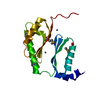
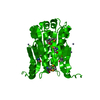
 要素
要素 Acinetobacter baumannii (バクテリア)
Acinetobacter baumannii (バクテリア)
 X線回折 / 使用した結晶の数: 1
X線回折 / 使用した結晶の数: 1  試料調製
試料調製 シンクロトロン / サイト:
シンクロトロン / サイト:  Australian Synchrotron
Australian Synchrotron  / ビームライン: MX1 / 波長: 0.987 Å
/ ビームライン: MX1 / 波長: 0.987 Å 解析
解析 単波長異常分散 / 解像度: 1.65→35.904 Å / SU ML: 0.19 / 交差検証法: THROUGHOUT / σ(F): 1.34 / 位相誤差: 23.48
単波長異常分散 / 解像度: 1.65→35.904 Å / SU ML: 0.19 / 交差検証法: THROUGHOUT / σ(F): 1.34 / 位相誤差: 23.48  ムービー
ムービー コントローラー
コントローラー




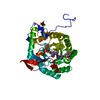
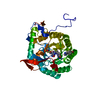
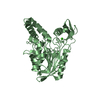

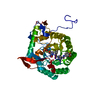
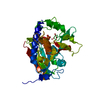
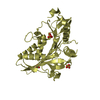

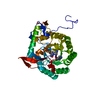
 PDBj
PDBj







